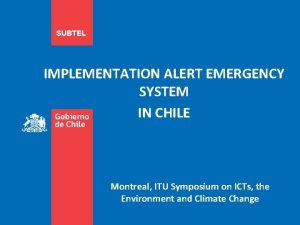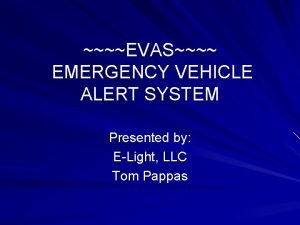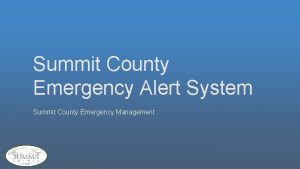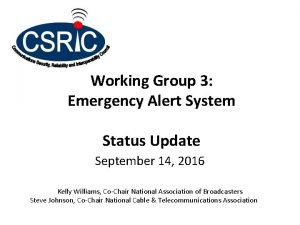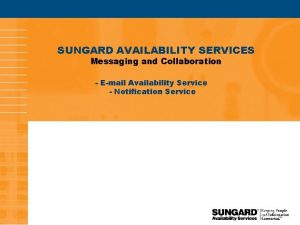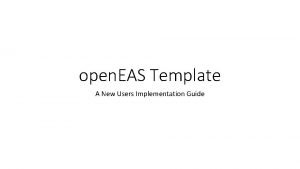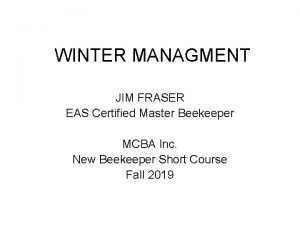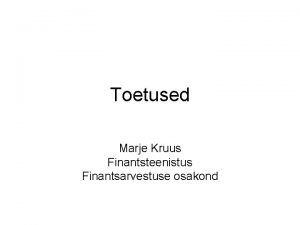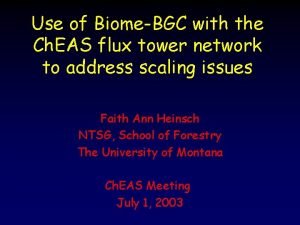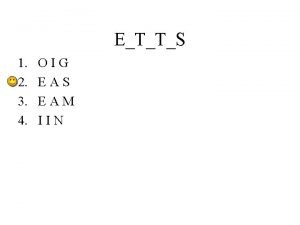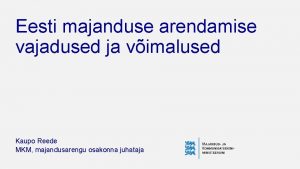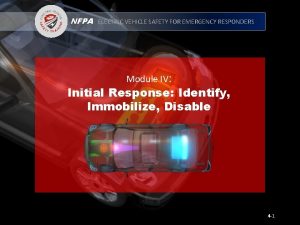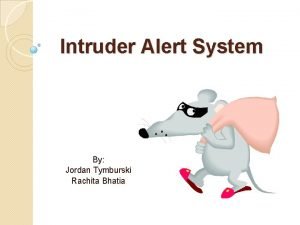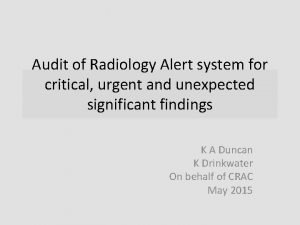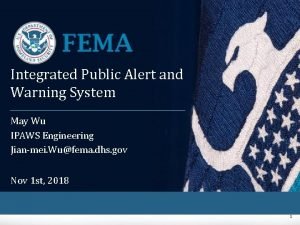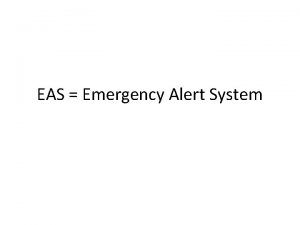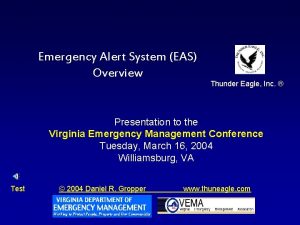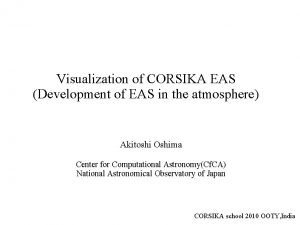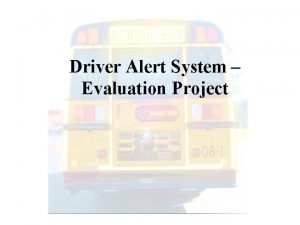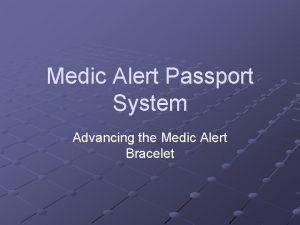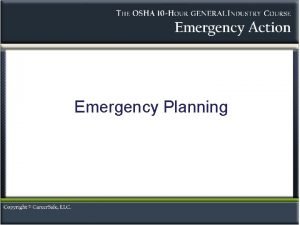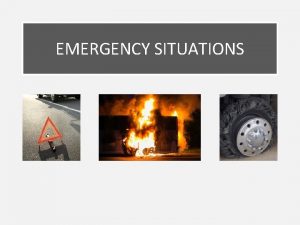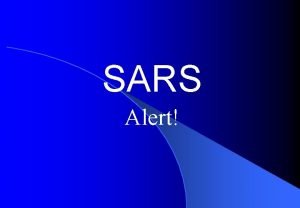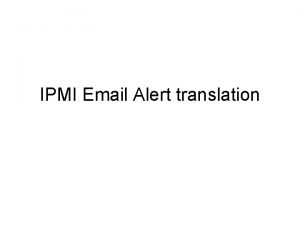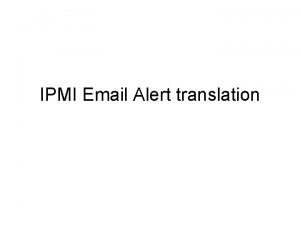A Guide to the Emergency Alert System EAS






















































- Slides: 54

A Guide to the Emergency Alert System (EAS) and Wireless Emergency Alert (WEA) System Public Safety and Homeland Security Bureau Federal Communications Commission July 25, 2018 Email Questions to: PLD@fcc. gov

Alerting is a Priority Integral to the FCC’s mission: “promoting safety of life and property through the use of wire and radio communication” 47 U. S. C. § 151 U. S. National Policy “It is the policy of the United States to have an effective reliable, integrated, flexible, and comprehensive system to alert and warn the American people in situations of war, terrorist attack, natural disaster, or other hazards to public safety and well-being (public alert and warning system), taking account of functions, capabilities, and needs and to ensure that under all conditions the President can communicate with the American people. ” Executive Order 13407, “Public Alert and Warning System” (June 26, 2006)

Alerting Systems (Commercial Communications Infrastructure) ● The Emergency Alert System (EAS) is a national public warning system commonly used by state and local authorities to deliver important emergency information, such as weather and AMBER alerts, to affected communities. EAS Participants – radio and television broadcasters, cable systems, satellite radio and television providers, and wireline video providers – deliver local alerts on a voluntary basis, but they are required to provide the capability for the President to address the public during a national emergency. ● The Wireless Emergency Alert (WEA) system delivers critical warnings and information to the public on their wireless devices. Participation by wireless providers is voluntary, but those that offer the service must adhere to the technical and operational requirements established by the FCC.

Basic Alerting Model Commercial Communications Trusted Source Basic Alerting Model Infrastructure The Public Both the EAS and WEA follow this approach

Trusted Sources ● Who or what are trusted sources? − The President of the United States − − − The National Weather Service State, local, county governments o Emergency management agencies o State police National Center for Missing and Exploited Children (NCMEC) for AMBER Alerts

Trusted Sources ● How to become a trusted source: − − − Understand the alerting systems that are available to you. Get training and authorization from FEMA: https: //www. fema. gov/how-signipaws Work with your fellow alerting stakeholders: o o State Emergency Communications Committees (SECCs) are volunteer organizations that administer the EAS at the state and local level. Get familiar with your State EAS Plans describe state and local EAS operations, and contain guidelines which must be followed to activate the EAS: https: //www. fcc. gov/public-safety-and-homelandsecurity/policy-and-licensing division/alerting/general/state-eas-plans FEMA IPAWS Team and testing lab: https: //www. fema. gov/testing-ipawslab-jitc National Weather Service – local coordination meteorologists: https: //www. weather. gov/stormready/contact

The Emergency Alert System (EAS) ● EAS Rules – 47 CFR § 11. 1, et seq. ● EAS Participants must deliver Presidential alerts and nationwide, monthly and weekly tests. ● − Delivery of other alerts (weather, state, AMBER) is voluntary. − EAS Alerts must be accessible to people with disabilities. EAS Distribution: − EAS alerts are delivered to EAS Participants either over the internet from FEMA’s Integrated Public Alert and Warning System (IPAWS) gateway or by over-the-air broadcast. − EAS Participants are required to monitor both systems for redundancy, but IPAWS offers digital sound, enhanced text, non-English alerts, multi-media, and urls

EAS Distribution over IPAWS Integrated Public Alert and Warning System (IPAWS)

Another way to look at the daisy chain

EAS - Recent Commission Actions ● Emergency Alert Reliability Report and Order and FNPRM The Report and Order: − Adopts requirements for performing “Live Code Tests, ” i. e. , local EAS tests that use actual EAS alert codes to train communities in how to respond to actual alerts and to increase the proficiency of the alert originators. − Adopts requirements that permit EAS Participants to deliver public service announcements (PSAs) that use the EAS Attention Signal (the 8 -second, two-tone audio signal) and a simulation of the Header Code tones (three audible tones that follow the Attention Signal). − Helps prevent false alerts by requiring that EAS Participants configure their EAS equipment to reject Common Alerting Protocol-based alerts that contain an invalid digital signature and legacy (over-the-air)-based alerts whose expiration time falls outside of specific time limits. Requires an EAS Participant to email the FCC’s 24/7/365 Operations Center within 24 hours of its discovery that it has sent a false alert. −

EAS - Recent Commission Actions ● Emergency Alert Reliability Report and Order and FNPRM Further Notice of Proposed Rulemaking: − Seeks further comment on whethere is a need for additional false alert and lockout reporting beyond that required by the Order. − Proposes that the EAS rules should be revised to require State EAS Plans to include procedures for preventing and correcting false alerts.

EAS - Recent Commission Actions ● Automating State EAS Plans − ● The FCC adopted rules creating a new, streamlined electronic system for the filing of State EAS Plans that will increase the effectiveness and efficiency of the EAS, while reducing burdens on stakeholders. Blue Alerts − − A new EAS category that will allow state and local authorities to notify the public of threats to law enforcement and to help apprehend dangerous suspects Blue Alerts will warn the public when a law enforcement officer is missing, seriously injured or killed in the line of duty, or when is subject to an imminent credible threat Must be implemented for EAS by January 19, 2019 Must be implemented for WEA by July 19, 2019

Wireless Emergency Alerts (WEA) ● WEA Rules – 47 CFR Sections 10. 1, et seq. ● Established pursuant to Warning, Alert and Response Network (WARN) Act ● Uses the IPAWS architecture ● Three categories of WEA alerts: Presidential, Imminent Threat and AMBER

WEA Architecture

WEA - Recent Commission Actions ● ● ● Improved geo-targeting so that the alerts reach communities affected by an emergency without disturbing others: − Participating wireless providers are currently required to “best approximate” the area to be alerted − Participating wireless providers will be required to match the area within 1/10 of a mile by November 2019 Improved alert message content to help communities communicate clearly and effectively: − Active URLs (web sites and telephone numbers) o National wireless providers are currently required to support active links o Regional providers will be required to support links by May 1, 2019 − Message length will increase from 90 to 360 characters by May 1, 2019 − Participating wireless providers must support Spanish language alerts by May 1, 2019 End-to-end WEA testing will be allowed in May 1, 2019 ● Some waivers have been granted to permit end-to-end WEA tests prior to May 1, 2019

WEA - Recent Commission Actions ● Emergency Alert Reliability Report and Order and FNPRM Further Notice of Proposed Rulemaking: − Notes that the Bureau’s Hawaii False Alert report indicated that some wireless subscribers did not receive the WEA false alert and subsequent correction; likewise, press reports of recent WEA tests indicated that some subscribers did not receive the WEA test message. − Seek comment on factors, such as network distribution issues, that might delay or prevent delivery of WEA alerts to members of the public. − Seeks comment on whether and if so, how, the Commission should take measures to address inconsistent WEA delivery. − For example, should the Commission adopt technical standards (or benchmarks) for WEA performance and delivery?

2017 Nationwide EAS Test ● ● ● On September 27, 2017, at 2: 20 pm, FEMA, in coordination with the FCC and the National Weather Service conducted a nationwide test of the EAS. The nationwide test was designed to assess the reliability and effectiveness of the EAS, with an emphasis on testing the IPAWS and to provide the Commission with an opportunity to evaluate improvements implemented since the 2016 nationwide EAS test. The Public Safety and Homeland Security Bureau released its full report on April 13, 2018: − Overall, the 2017 Nationwide EAS Test demonstrated that IPAWS continues to deliver high-quality, effective, and accessible EAS alerts. − Test data also reveal technical impediments to the full reception of EAS alerts effectively over IPAWS and that interference with closed captioning and other practices impeded the full accessibility of the test.

2018 Nationwide EAS Test ● On September 20, 2018, FEMA, in coordination with the FCC, will be conducting a combined nationwide test of the EAS and WEA. − − ● At 2: 18 p. m. Eastern Daylight Time (EDT), FEMA, using the Presidential classification, will send a WEA test message to WEA-capable wireless devices throughout the entire United States. At 2: 20 p. m. EDT, FEMA will conduct a live test of the EAS, which will be disseminated via the Integrated Public Alert and Warning System (IPAWS). EAS Participants are reminded that they are required to file with the EAS Test Reporting System (ETRS) as follows: − − − Complete Form One on or before August 27, 2018 File Form Two data on or before 11: 59 p. m. EDT, September 20, 2018 File Form Three on or before November 5, 2018

Hawaii False Alert Report and Recommendations ● ● On January 13, 2018, the State of Hawaii Emergency Management Agency mistakenly sent a false ballistic missile alert using the EAS and WEA FCC’s Public Safety and Homeland Security Bureau investigated the event and released a report with recommendations to guard against and mitigate false alerts: https: //www. fcc. gov/document/fcc-releases-report-hawaii-false -emergency-alert

Hawaii False Alert Report and Recommendations ● Recommendations include: − − − Establishing redundant and effective lines of communication with key stakeholders during emergencies Conducting regular internal tests in a controlled and closed environment, such as FEMA’s Integrated Public Alert and Warning System (IPAWS) Test Lab Requiring more than one credentialed person to validate message content prior to transmission of a high-impact alert, as well as all tests Implementing specific upgrades to alerting software and developing standard operating procedures for responding to false alerts Consult with SECCs on a regular basis—at least annually—to ensure that EAS procedures, including initiation and cancellation of actual alerts and tests, are mutually understood, agreed upon, and documented in the State EAS Plan.

Alerting Roundtable and Other Outreach ● ● ● On May 15, 2018, the Bureau hosted a public roundtable with stakeholders to share lessons learned and to promote a continued dialogue. Recommendations and major take-aways: − Engage in proficiency training and adopt best practices for alerts and tests − Building local relationships is essential. Stakeholders, including SECCs and State emergency managers, should meet on a regular basis. − State personnel responsible for initiating alerts should take the training offered by FEMA and practice using the FEMA IPAWS lab, which can be accessed online. − An archived webcast of the roundtable can be viewed here: https: //www. fcc. gov/news-events/2018/05/emergency-alertingroundtable The Commission and the Public Safety and Homeland Security Bureau will continue to conduct outreach and work together with government and industry stakeholders.

Questions? Thank You! Gregory M. Cooke Deputy Chief, Policy & Licensing Division Public Safety & Homeland Security Bureau Federal Communications Commission (202) 418 -2351 (office) (301) 466 -2441 (mobile) gregory. cooke@fcc. gov Email Questions to: PLD@FCC. gov

Integrated Public Alert and Warning System Wade Witmer wade. witmer@fema. dhs. gov >>> IPAWS@fema. dhs. gov July 19, 2018

Agenda • • IPAWS Program How IPAWS Works How to Get On-line Best Practices, IPAWS Lab, Train and Test 24

IPAWS a National System for Local Alerting – Provides local, state, territorial, tribal, and federal agencies access to geotargeted emergency alert and warning methods: • Wireless Emergency Alerts (WEA) – broadcast to cell phones in an area • Emergency Alert System (EAS) - traditional radio/TV warning • Internet applications and websites • NOAA All Hazards Weather Radio* – FEMA**: • Builds and operates the IPAWS-OPEN aggregator and gateway interfaces • Administers users of the system in coordination with applicable STTL authorities • Works with private sector and FCC to continuously enhance and deliver new alerting capabilities * IPAWS – NOAA connections for NWEM and EAS are offline **in accordance with Public Law 114 -143 - The IPAWS Modernization Act of 2015; Executive Order 13407 - Public Alert and Warning System; and the Robert T. Stafford Disaster Relief and Emergency Assistance Act, Sec. 202. Disaster Warnings 25

Authorities with IPAWS Public Alerting as of April 19, 2018 1, 045 Total IPAWS Public Alerting Authorities: 66. 7% of the population are covered by a local alerting authority with IPAWS access Counties in green have at least one local authority 970* Local (*includes 15 military bases) 67 State-wide 3 Territory 3 Tribal 2 National 3

IPAWS Usage Statistics (as of April 17, 2018) (Totals from April 2012 through January 17 th, 2018) 36, 938 34, 788 1, 192 958 11, 200 10, 276 926 2, 835, 468 • Total Wireless Emergency Alert (WEA) messages sent • WEAs sent by NWS • WEAs sent by NCMEC • WEAs sent by state/local • Total Emergency Alert System (EAS) messages sent • EAS, including tests, sent by state/local • EAS non-test sent by state/local • Total* messages processed by IPAWS Aggregator *not all messages sent to the public 27

IPAWS WEA Usage Statistics (as of Jan 17, 2018) WEA sent by local, state, territorial Authorities monthly since 2012 * 317 WEA sent in 2017 by SLT *Chart does not include over 32, 000 alerts sent by NWS or over 1, 000 AMBER Alerts sent by NCMEC since 2012 EAS Activations NOAA Weather WEAs Non-Weather WEAs 28

IPAWS PMO Initiatives: to improve the readiness and effectiveness of State, local, territorial, and tribal authorities to alert and warn the public • • • Outreach and educational briefings at regional, State, and local conferences to promote best practices for effective public alert and warning procedures, training, and exercises Revamping IPAWS specific training courses (IS-247 & 251) Reviewing Emergency Management Institute (EMI) course catalog to insert additional IPAWS information and update and ensure public alert and warning content is consistent Engaging the other FEMA resources to incorporate public alert and warning planning, training, practice, and exercising into the NIMS Framework. Engaging mass notification/alerting tool developers to ensure commercial products are intuitive, clearly separate test from live alerts, provide adequate training Establishing an IPAWS User Workgroup on the MAX Federal Community; an information sharing environment for peer to peer discussion, insights, software tool notes, SOPs/local practices, lessons learned, and public alerting experience

Agenda • • IPAWS Program How IPAWS Works How to Get On-line Best Practices, IPAWS Lab, Train and Test 30

Common public notification/alert/warning methods Method: Social Media (Facebook, Twitter, Instagram, etc) People must be actively Text Message and Email seeking info or pre. Telephone register for push notifications Emergency Use Considerations: – Are you being actively followed before an incident? – who’s following you? – how often do you post, how frequently are posts re -tweeted, liked, commented on? – how current is your data base? – Message delivery can be delayed by network congestion – how current is your data base? – what % of calls are answered by a person? – Message delivery can be delayed by network congestion Agency Website – what’s your typical daily page traffic pre-incident? – are hits from local people? Local Media Coverage – Are people tuned in before the emergency? Door-to-Door – Time and personnel intensive Sirens, mobile loud speakers – Do people know what the siren means? Wireless Emergency Alerts IPAWS location Emergency Alert System based alerts – Text broadcast to any cell phone in the area – interrupts local TV/Radio, but only reaches active listeners 31

IPAWS Architecture * * IPAWS – NOAA connections for NWEM and EAS are offline 32

How does an Alerting Authority use IPAWS? …via one of more than 40 vendors with IPAWS interoperability… Sampling of Vendors: E Team® On-The-Go Alerting Swift 911™ VESTA® Alert 33

Alert Aggregation What the Aggregator does: 1. Authenticates sender A. Web Service Security B. Digital Signature Ensures non-repudiation and message integrity 2. Validates CAP message format 3. Verifies message is compliant with senders’ permissions A. What alerts can you send B. Where can you send them C. How can you send them 34

Alert Dissemination and Receipt by the Public • EAS – Broadcast – Large footprint – County-based • WEA – Broadcast – Medium footprint – Polygon based • NOAA Weather Radio * – Broadcast – Large footprint – County-based * IPAWS – NOAA connections for NWEM and EAS are offline 35

Emergency Alert System – FCC regulations require all radio, TV, cable stations to monitor the IPAWS EAS feed and, in accordance with your state EAS plan, other radio/TV stations sources – Audio announcement and text display interrupts programming – Emergency messages sent via IPAWS to EAS can support : • Full message text for screen crawl/display • Audio Attachments (mp 3) • Additional languages ØCheck with your local stations to see if they will play alternate language messages 36

Emergency Alert System (EAS) Requires Local Coordination & Partnership Ø Stations are not required to air local emergency messages! • Please go meet with them before you have an emergency Ø EAS “activation” interrupts programing once only! • Emergency message audio/text is repeated twice – then regular program continues • TV display format varies station to station 37

Wireless Emergency Alerts Ø “Cell Broadcast” technology • Not affected by cell site network congestion • Sent to all phones in the area Ø Significantly different from SMS/email sign-up based alerting services Not subscription based • True location based alerting - sends alerts to all phones in a cell coverage area - not to a database of phone numbers • No sign-up or registration • No app • No tracking or delivery info or status feed back Ø Phones are delivered opted-in - but can be turned off in settings. Ø 90 character text only message • Can include a URL/web link!

Wireless Emergency Alerts Ø Alerts can be geo-targeted to area small than a county! • Targeting is based on cell tower locations some alert creation tools do not support WEA geo-targeting 39

Wireless Emergency Alerts Ø Alert area must include a cell tower! Ø Phones using towers in the target area will get message – Some phones may display the message later than others Ø Cell network should rebroadcast the WEA in the target area until message expires or is cancelled – Only phones new to the area should display rebroadcast messages 40

Changes to WEA in the works… Participating wireless carriers must support changes to WEA regulations by 2019*: FCC adopted in September 2016: § § § Increase message length from 90 to 360 characters by May 2019 Add new alert category, “Public Safety Messages” by May 2019 Spanish language WEA by May 2019 WEA test code by May 2019 Support URLs and phone numbers o Text URLs and phone numbers as of Nov 2016 o “Clickable” URLs and phone numbers as of Nov 2017 FCC adopted in January 2018: Requires changes to alerting tool interfaces and FEMA’s IPAWSOPEN § Hit 100% target area within 0. 1 mile overshoot by Nov 2019 § Preserve alerts on phone for 24 hours by Nov 2019 *Changes will be phased into network and phone upgrades. i. e. 90 character and broad geo-targeting will remain in some areas and some phones for years TBD 15

NOAA and IPAWS - Important! 4 Connection from IPAWS to NOAA Weather Radio for Non-Weather Emergency Messages (NWEM) is offline! – NWEM support can requested by coordination with local Weather Forecast Offices 4 NOAA is not sending weather warning to EAS via IPAWS – EAS stations must get NOAA weather warnings via alternate sources. e. g. monitoring local NOAA Weather Radio stations, state relay networks, etc. OFFLINE 42

IPAWS All-Hazards Info Feed 4 Internet and web services/applications monitoring alerts for the public 4 Web services may distribute or publish alert info to apps, websites, email lists, text messaging groups, social media, etc. 4 Sample of companies with access to the All-Hazards Alert Feed: • • At. Hoc, Inc. ATI Systems, Inc. Avalution Consulting, LLC Broadcast Television Group, LLC • Burli Software, Inc. • Callaway Graphic. Software • City of Lakewood • Comm. Power, Inc. • Deaf Link Inc. • Dotomi • EZ Automation • Facebook • Twitzip • Geo-Comm • Global Security Systems • • • • Grandpaham. com Interop Solutions, LLC KDEE Technology, LLC MIR 3, LLC My. State. USA, Inc. National Public Radio Omnilert, LLC PIER Systems LLC Public Alerter, LLC Rapid Notify, Inc. Rave Wireless Safe. T, Inc. Samsung Information Systems America Inc. • Singlewire Software LLC • Skitter Inc. • • • Spectacular Media Spectrum Solutions Swan Island Networks, Inc. Tech. Radium, Inc. The Weather Channel Companies Thunder Eagle, Inc. Tri. State. Alerts, LLC Weather Message Software WHDT World Television Service Wisemen Multimedia WRAL-TV, Capitol Broadcasting Company, Inc. 43

Agenda • • IPAWS Program How IPAWS Works How to Get On-line Best Practice, IPAWS Lab, Train and Test 44

Getting Access to IPAWS FIRST: Check with your State POC for alerting policy. Email IPAWS@fema. dhs. gov for an MOA application, instructions, and information. 1. Obtain an IPAWS-compatible alerting tool 2. Complete a Memorandum of Agreement 3. Complete the “Public Alerting Application” –Coordinate with the state and obtain signature 4. Complete IPAWS web-based training After FEMA IPAWS office has the state coordinated “Public Alerting Application” and your completed training certificate, public alerting will be enabled in your agencies profile in the IPAWS and you can begin to send alerts. Ø Digital Certificates expire after 3 years. Your alerts will be rejected when certificate is expired. Check your certificate expiration date! Ø Ensure IPAWS Office has up to date contact information for your agency! 45

Agenda • • IPAWS Program How IPAWS Works How to Get On-line Best Practices, IPAWS Lab, Train and Test 46

Alert and Warning Best Practices – Develop Local Policy, Plans and Procedures • Assign alerting roles and responsibilities • Establish guidelines for what and when to send • Identify common local hazards • Create procedural checklists • Draft local hazard emergency messages • Establish neighboring jurisdiction coordination plans • Share information with public • Review, update, revise periodically 47

Alert and Warning Best Practices – Train and Practice • Be ready to use public alerting tools in an emergency • Use the IPAWS Lab – Educate and Inform Public • Educate the public on capabilities – Coordinate with neighboring jurisdictions – Exercise and Test • Exercise regularly with off-line systems • Send periodically “live code” test to the public • Involve the public and solicit feedback 48

Train, Practice, Test using your alert/warning tool! 49

IPAWS Lab - “offline” version of IPAWS …Practice sending alerts! Production Certificate Live networks = people’s TVs, radios & cell phones! IPAWS OPEN Emergency Test Environment devices at the IPAWS Lab only IPAWS LAB Test Certificate Emergency 50 50

IPAWS Lab - Test Message Viewer Website Web page to see the result of alerts sent to the IPAWS Lab environment: Uses: • practice using tools, creating and sending alerts • test, exercise, and train alert senders • https: //ipawsopen. net/ALERT_SERVICES/postedmess ages. php? COGID=[your COGID# here]

Use the IPAWS Lab! • The IPAWS Lab supports: – Training and testing in a safe/closed environment – 18+ sample alert origination tools – All EAS dissemination devices – Other devices capable of receiving IPAWS – Hands-on training – Virtual and table-top exercise support – Scenario and best-practice review – Expert assistance – Supports the “IPAWS Message Viewer” – allows for individual training/testing 52

Live Testing ØOnly way to know how a WEA will behave in your area • Cell network configurations are different in every locality 4 Recommended testing actions outline: Ø Check in with IPAWS Office – Make a test plan Ø Coordinate with FCC for waiver – Test and practice against the IPAWS Lab environment and Alert Viewer – Tell the public about the test details • what the message will say • where alert will be targeted • How phones that get the test will sound and behave – Conduct the test – Ask public for comments after the test • e. g. Where were they when they got the WEA. – Report back to the public on how the test went 53 53

IPAWS Program Office FEMA Resilience, National Continuity Programs, IPAWS Division ipaws@fema. dhs. gov 54
 Eas alarm chile
Eas alarm chile Emergency vehicle alert system
Emergency vehicle alert system Summit county alerts
Summit county alerts Wg eas system
Wg eas system Sungard eas
Sungard eas Openeas
Openeas Eas significato
Eas significato Esempi di eas scuola primaria
Esempi di eas scuola primaria Eas constructed response examples
Eas constructed response examples Eas master beekeeper
Eas master beekeeper Avaliku sektori finantsarvestuse ja -aruandluse juhend
Avaliku sektori finantsarvestuse ja -aruandluse juhend Fasi eas
Fasi eas Eas
Eas Eas
Eas Chime eas
Chime eas Eas
Eas Eas 4300
Eas 4300 Eas rup
Eas rup Electric vehicle emergency field guide
Electric vehicle emergency field guide Prehospital emergency care 11th edition study guide
Prehospital emergency care 11th edition study guide Electric vehicle emergency field guide
Electric vehicle emergency field guide Intruder alert system
Intruder alert system Radiology alert system
Radiology alert system Medical alert system
Medical alert system Integrated public alert and warning system
Integrated public alert and warning system Hình ảnh bộ gõ cơ thể búng tay
Hình ảnh bộ gõ cơ thể búng tay Slidetodoc
Slidetodoc Bổ thể
Bổ thể Tỉ lệ cơ thể trẻ em
Tỉ lệ cơ thể trẻ em Voi kéo gỗ như thế nào
Voi kéo gỗ như thế nào Tư thế worms-breton
Tư thế worms-breton Chúa sống lại
Chúa sống lại Các môn thể thao bắt đầu bằng tiếng nhảy
Các môn thể thao bắt đầu bằng tiếng nhảy Thế nào là hệ số cao nhất
Thế nào là hệ số cao nhất Các châu lục và đại dương trên thế giới
Các châu lục và đại dương trên thế giới Cong thức tính động năng
Cong thức tính động năng Trời xanh đây là của chúng ta thể thơ
Trời xanh đây là của chúng ta thể thơ Cách giải mật thư tọa độ
Cách giải mật thư tọa độ Làm thế nào để 102-1=99
Làm thế nào để 102-1=99 Phản ứng thế ankan
Phản ứng thế ankan Các châu lục và đại dương trên thế giới
Các châu lục và đại dương trên thế giới Thể thơ truyền thống
Thể thơ truyền thống Quá trình desamine hóa có thể tạo ra
Quá trình desamine hóa có thể tạo ra Một số thể thơ truyền thống
Một số thể thơ truyền thống Bàn tay mà dây bẩn
Bàn tay mà dây bẩn Vẽ hình chiếu vuông góc của vật thể sau
Vẽ hình chiếu vuông góc của vật thể sau Biện pháp chống mỏi cơ
Biện pháp chống mỏi cơ đặc điểm cơ thể của người tối cổ
đặc điểm cơ thể của người tối cổ Thứ tự các dấu thăng giáng ở hóa biểu
Thứ tự các dấu thăng giáng ở hóa biểu Vẽ hình chiếu đứng bằng cạnh của vật thể
Vẽ hình chiếu đứng bằng cạnh của vật thể Vẽ hình chiếu vuông góc của vật thể sau
Vẽ hình chiếu vuông góc của vật thể sau Thẻ vin
Thẻ vin đại từ thay thế
đại từ thay thế điện thế nghỉ
điện thế nghỉ Tư thế ngồi viết
Tư thế ngồi viết
